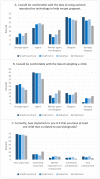Differences in Women's Use of Medical Help for Becoming Pregnant by the Level of Urbanization of County of Residence in Georgia
- PMID: 26769080
- PMCID: PMC4945485
- DOI: 10.1111/jrh.12172
Differences in Women's Use of Medical Help for Becoming Pregnant by the Level of Urbanization of County of Residence in Georgia
Abstract
Purpose: Our goal was to determine if there are differences by place of residence in visiting a doctor for help getting pregnant in a population-based study.
Methods: Using data from the Furthering Understanding of Cancer, Health, and Survivorship in Adult (FUCHSIA) Women's Study, a cohort study of fertility outcomes in reproductive-aged women in Georgia, we fit models to estimate the association between geographic type of residence and seeking help for becoming pregnant.
Findings: The prevalence of visiting a doctor for help getting pregnant ranged from 13% to 17% across geographic groups. Women living in suburban counties were most likely to seek medical care for help getting pregnant compared with women living in urbanized counties (adjusted prevalence ratio (aPR) = 1.14, 95% CI: 0.74-1.75); among women who reported infertility this difference was more pronounced (aPR = 1.59, 95% CI: 1.00-2.53). Women living in rural counties were equally likely to seek fertility care compared with women in urbanized counties in the full sample and among women who experienced infertility.
Conclusions: Women living in urban and rural counties were least likely to seek infertility care, suggesting that factors including but not limited to physical proximity to providers are influencing utilization of this type of care. Increased communication about reproductive goals and infertility care available to meet these goals by providers who women see for regular care may help address these barriers.
Keywords: access to care; fertility care; geographic disparities; infertility; utilization of health services.
© 2016 National Rural Health Association.
Figures
References
-
- Chachamovich JR, Chachamovich E, Ezer H, Fleck MP, Knauth D, Passos EP. Investigating quality of life and health-related quality of life in infertility: a systematic review. Journal of psychosomatic obstetrics and gynaecology. 2010;31(2):101–110. - PubMed
-
- Sunderam S, Kissin DM, Crawford S, et al. Assisted reproductive technology surveillance -- United States, 2010. Morbidity and mortality weekly report. Surveillance summaries (Washington, D.C. : 2002) 2013;62(9):1–24. - PubMed
-
- Nangia AK, Likosky DS, Wang D. Access to assisted reproductive technology centers in the United States. Fertility and sterility. 2010;93(3):745–761. - PubMed
-
- Chandra A, Copen CE, Stephen EH. Infertility service use in the United States: data from the National Survey of Family Growth, 1982-2010. National health statistics reports. 2014;(73):1–21. - PubMed
-
- Missmer SA, Seifer DB, Jain T. Cultural factors contributing to health care disparities among patients with infertility in Midwestern United States. Fertility & Sterility. 2011;95(6):1943–1949. - PubMed
Publication types
MeSH terms
Grants and funding
LinkOut - more resources
Full Text Sources
Other Literature Sources
Medical
Miscellaneous


